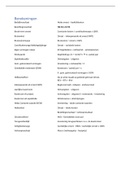Samenvatting
Summary of the course "Introduction to psychology and its methods" at the VU, period 1 first year AI
- Instelling
- Vrije Universiteit Amsterdam (VU)
This summary captures the first year course at the VU for the study Artificial Intelligence, named Introduction to Psychology and its methods. It captures both the lectures and the books discussed in the course. This summary uses bullet points to separate information, with sentences no longer than ...
[Meer zien]












